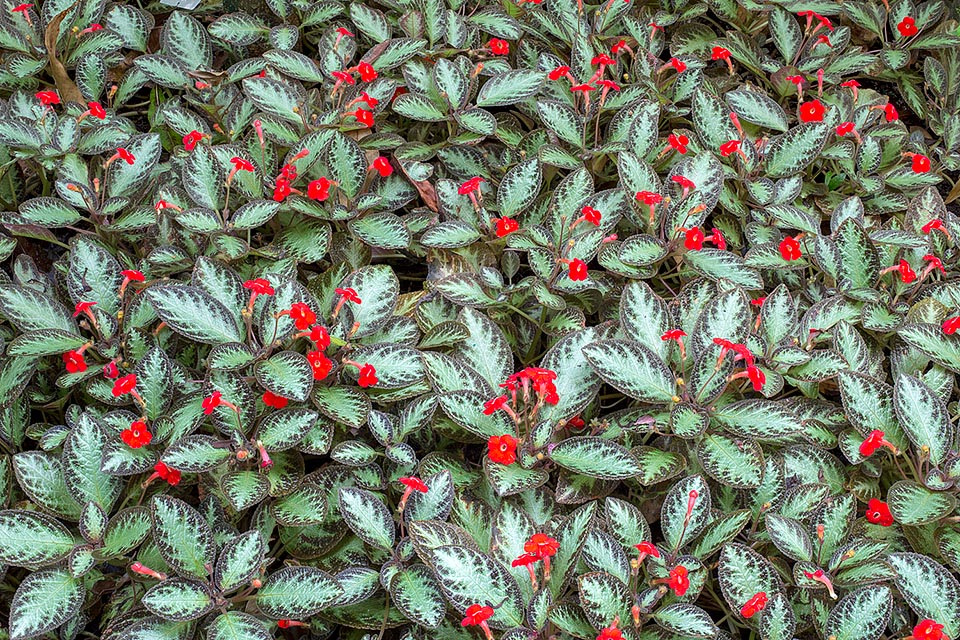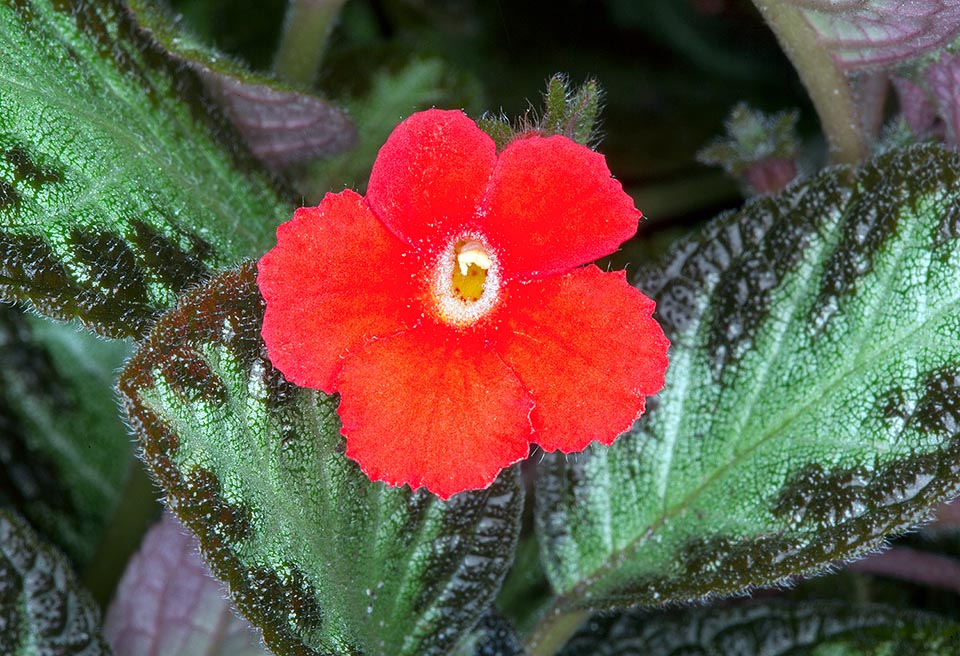Family : Gesneriaceae

Text © Pietro Puccio

English translation by Mario Beltramini
The species is native to Colombia, Ecuador, El Salvador, Honduras, Mexico (Chiapas and Oaxaca), Nicaragua, Panama and Venezuela where it grows in the underwood of the humid forests at low and medium altitudes.
The name of the genus is the combination of the Greek preposition “ἐπί “ (epi) = over, in, and of the substantive “σκιά” (sciá) = shade with referenced to the shady places where it lives; the name of the species is the Latin adjective “cupreatus, a, um” = auburn, with reference to the colour of the leaves.
Common names: flame violet, carpet plant, trailing violet (English); kobberplante (Danish); épiscia, épiscie (French); asa-da-barata, epícia, planta-tapete, violeta-vermelha (Portuguese); cirtodeira, violeta flamígera (Spanish); skarlátvörös árnyékcsuporka (Hungarian); Schattenröhre (German); ấm kiến (Vietnamese).
The Episcia cupreata (Hook.) Hanst. (1866) is a perennial herbaceous species, evergreen, stoloniferous, 10-25 cm tall, with fleshy stems, of about 0,5 cm of diameter, creeping, pubescent, rooting at the nodes, with apices pointing upwards. The leaves, on a 2,5-4,5 cm long petiole, are simple, opposite or in verticils of 3, elliptical to oblong-ovate with obtuse or acute apex and slightly serrate margin, wrinkly, pubescent, from green to dark auburn colour with metallic reflections above, and pale green or silvery variegations along the veins, pinkish and pubescent below, 6-12 cm long and 5-8 cm broad.

Frequent in culture with several hybrids and varieties, Episcia cupreata is a perennial hebarceous species, evergreen, stoloniferous of Central America © Giuseppe Mazza
Subsessile axillar inflorescences, with 1-4 flowers, on a reddish hirsute pedicel, 4-7 cm long, almost horizontal, calyx with 5 unequal lobes, briefly united at the base, oblanceolate, with obtuse apex and crenate margins, pubescent, scarlet red imbutiform corolla with yellow throat dotted red, pubescent tube, 2-3 cm long, with 5 roundish lobes with toothed and ciliate margins, 0,8-1 cm long, 4 didynamous stamens and pubescent globose ovary. The fruits are hirsute bivalve globose capsules, of about 0,5 cm of diameter, containing numerous tiny ellipsoidal seeds of brown colour.
It reproduces by seed, scattered on draining organic loam maintained humid at the temperature of 24-26 °C, with germination times of 1-3 weeks, by micro propagation and easily by cutting of stem or of leaf and especially through the stolons.
The species with its several hybrids and varieties, that differ for colour and variegations of the leaves and colour of the flowers, is one of the most popular and appreciated indoor plants, besides being a wonderful subject as ground cover for the shady gardens of the tropical and humid subtropical climate regions. When in apartment requires a very luminous position in order to exalt its colours, but not in direct sun, and sheltered from drafts, with temperatures not under the 16 °C and humidity over the 50%.

10-25 cm tall has fleshy stems, of about 0,5 cm of diameter, creeping, pubescent, rooting at nodes. Very decorative leaves and scarlet flowers, also in apartment © G. Mazza
If the humidity is not sufficient recourse can be done to humidifiers or to the classical method of positioning the pot on a large saucer filled up with expanded clay or crushed stone with a layer of water, not in direct contact with the bottom of the pot, thus to create a humid micro environment. Of great ornamental effect cultivated in suspended pots thus allowing the stems to fall freely, is also a particularly decorative solution for humid tropical terraria. The loam must be rich of organic substance and particularly porous and draining, being easily subject to rottenness, is therefore necessary the addition of 30% of inerts, such as agriperlite or coarse siliceous sand. It is to be watered regularly during the vegetative period, utilizing non calcareous water at room temperature, but allowing the upper layer of the loam to dry up between the waterings, that are to be reduced in winter, but without ever allowing the loam to dry up completely, avoiding as much as possible wetting the leaves. Monthly fertilizations in spring-summer utilizing a hydrosoluble product balanced with micro element at 1/3 the dosage, or less, than that shown on the package.
Synonyms: Achimenes cupreata Hook. (1847); Cyrtodeira cupreata (Hook.) Hanst. (1854); Cyrtodeira trianae Hanst. (1857); Tapina splendens Linden (1857); Cyrtodeira cupreata var. viridifolia Hook. (1860); Episcia splendens (Linden) Hanst. (1866); Cyrtodeira cupreata f. metallica Regel (1869); Episcia cupreata var. viridifolia (Hook.) G.Nicholson (1885).
→ To appreciate the biodiversity within the GESNERIACEAE family please click here.
